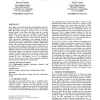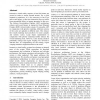4025 search results - page 222 / 805 » The Human Action Image |
HRI
2006
ACM
15 years 5 months ago
2006
ACM
The essence of the signal-to-symbol problem consists of associating a symbolic description of an object (e.g., a chair) to a signal (e.g., an image) that captures the real object....
ICRA
2006
IEEE
15 years 5 months ago
2006
IEEE
— In the eyes of many species, the optical nodal points of the cornea and lens do not lie on the axes of rotation of the eye. During eye movements, this lack of alignment produce...
MHCI
2009
Springer
15 years 3 months ago
2009
Springer
In this paper, we describe the design and ethnographic study of a phone developed so as to allow people to glance at each other, rather than simply message or voice call. Glanceph...
102
click to vote
MOBISYS
2008
ACM
15 years 10 months ago
2008
ACM
Over the course of a day a human interacts with tens or hundreds of individual objects. Many of these articles are nomadic, relying on human memory to manually index, inventory, o...
ACSC
2006
IEEE
15 years 5 months ago
2006
IEEE
Interactive virtual reality requires at least 60 frames per second in order to ensure smooth motion. For a good immersive experience, it is also necessary to have low end-to-end l...


